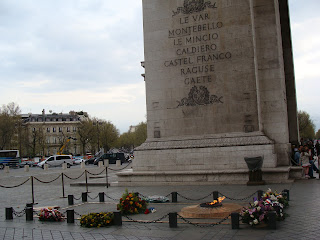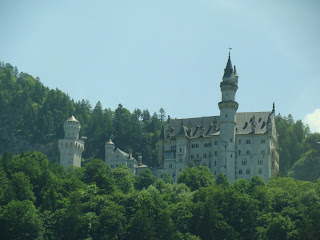Sunday, 29 July 2012
Wednesday, 25 July 2012
Arc de Triomphe
It is the centrepiece of the Place Charles de Gaulle-Etoile, from where it majestically overlooks the Champs Elysées. Commissioned by Napoleon in 1806 in homage to French military victories, the arch was completed 30 years later during the reign of Louis Philippe, the last King of France, who dedicated the monument to the glory of the revolutionary army and the French army in general. It is adorned with reliefs and sculptures depicting scenes from Napoleon’s epic battles.
The Big Hall within the monument has been redesigned. The new scenography is divided into seven sections and takes a modern, interactive approach to tracing the history of the Arc de Triomphe.
From the 50-metre high terrace on top of the Arc de Triomphe, you’re invited to admire each of the twelve avenues that stem from the monument, most of which bear the name of a famous battle fought by Napoleon, such as Friedland and Wagram. Paris is literally at your feet as you look out over the capital’s historic avenue with, on the one side, the Champs-Elysées, the place de la Concorde, the Tuileries Garden, and the Louvre and, on the other, the Arche de la Défense.
Marcadores:
Paris - France
Sunday, 22 July 2012
Wednesday, 18 July 2012
Oberbaumbrücke
Berlin’s double-decker bridge the Oberbaumbrücke (1895) - Oberbaum Bridge - links the two Berlin districts of Kreuzberg and Friedrichshain separated by the River Spree. Traffic runs on the lower part and trains on the second level. It was built on the site of a previous timber bridge built in 1724 when the construction of an elevated railway required a reinforced structure. The result was a seven-arched concrete bridge with a granite and brickwork façade. It is distinctive architecturally because of its mock medieval turrets – which recall the function of toll bridges and arches.
More recently the bridge starred in the Hollywood movie “The Bourne Supremacy” (2004) filmed on location in Berlin. Jason Bourne - played by Matt Damon - is seen crossing the Oberbaum Bridge in a Taxi on his way to the Westin Grand Hotel. A Cold War landmark of division between between east and west from 1961 to 1989 armed guards patrolled the banks of the river as a border area and the bridge was one of the crossover checkpoints from West to East only.
Today the bridge is adorned by graffiti and street artists’ work. A sandy beach for chilling out in the summer has replaced the barbed wire of the no man’s land and techno music is the distinctive sound from the scene in the re-united districts of Friedrichshain and Kreuzberg.
The bridge is also special in local lore because of the so-called “water-battle” event in tune with the traditional anarchist-bohemian character of the area. The bridge has separated the two districts since 1920 and since 1998 young people of all ages have converged here to fight an archaic-anarchic mock battle using assorted weapons such as rotten fruit and other harmless objects used as projectiles. The reason for the fight is unknown but it’s taking part that counts. With 70´s sounding names typical of the German agitprop resistance movements of those days, such as Water Army Friedrichshain (WAF) against Kreuzberg Patriotic Democrats/Realistic Centre (KPD/RZ) each side tries to defend the bridge and repel the adversary. A recent film, “Die Wasserschlacht” (The Water Battle) nominated for the Berlin Today Award (BTA) 2007 at the Berlin International Film Festival, tried to capture the origin of the combat trying to figure out how it all began.
Sunday, 15 July 2012
Wednesday, 11 July 2012
Subscribe to:
Posts (Atom)

















































